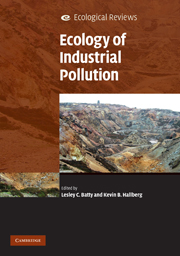Book contents
- Frontmatter
- Contents
- List of contributors
- Preface
- Acknowledgements
- 1 Consequences of living in an industrial world
- 2 Metallophytes: the unique biological resource, its ecology and conservational status in Europe, central Africa and Latin America
- 3 Lichens and industrial pollution
- 4 The impacts of metalliferous drainage on aquatic communities in streams and rivers
- 5 Impacts of emerging contaminants on the environment
- 6 Ecological monitoring and assessment of pollution in rivers
- 7 Detecting ecological effects of pollutants in the aquatic environment
- 8 With the benefit of hindsight: the utility of palaeoecology in wetland condition assessment and identification of restoration targets
- 9 An ecological risk assessment framework for assessing risks from contaminated land in England and Wales
- 10 Diversity and evolution of micro-organisms and pathways for the degradation of environmental contaminants: a case study with the s-triazine herbicides
- 11 The microbial ecology of land and water contaminated with radioactive waste: towards the development of bioremediation options for the nuclear industry
- 12 The microbial ecology of remediating industrially contaminated land: sorting out the bugs in the system
- 13 Ecological recovery in a river polluted to its sources: the River Tame in the English Midlands
- 14 Manchester Ship Canal and Salford Quays: industrial legacy and ecological restoration
- 15 Large-scale mine site restoration of Australian eucalypt forests after bauxite mining: soil management and ecosystem development
- 16 Sustaining industrial activity and ecological quality: the potential role of an ecosystem services approach
- Index
- Plate section
- References
11 - The microbial ecology of land and water contaminated with radioactive waste: towards the development of bioremediation options for the nuclear industry
Published online by Cambridge University Press: 05 June 2012
- Frontmatter
- Contents
- List of contributors
- Preface
- Acknowledgements
- 1 Consequences of living in an industrial world
- 2 Metallophytes: the unique biological resource, its ecology and conservational status in Europe, central Africa and Latin America
- 3 Lichens and industrial pollution
- 4 The impacts of metalliferous drainage on aquatic communities in streams and rivers
- 5 Impacts of emerging contaminants on the environment
- 6 Ecological monitoring and assessment of pollution in rivers
- 7 Detecting ecological effects of pollutants in the aquatic environment
- 8 With the benefit of hindsight: the utility of palaeoecology in wetland condition assessment and identification of restoration targets
- 9 An ecological risk assessment framework for assessing risks from contaminated land in England and Wales
- 10 Diversity and evolution of micro-organisms and pathways for the degradation of environmental contaminants: a case study with the s-triazine herbicides
- 11 The microbial ecology of land and water contaminated with radioactive waste: towards the development of bioremediation options for the nuclear industry
- 12 The microbial ecology of remediating industrially contaminated land: sorting out the bugs in the system
- 13 Ecological recovery in a river polluted to its sources: the River Tame in the English Midlands
- 14 Manchester Ship Canal and Salford Quays: industrial legacy and ecological restoration
- 15 Large-scale mine site restoration of Australian eucalypt forests after bauxite mining: soil management and ecosystem development
- 16 Sustaining industrial activity and ecological quality: the potential role of an ecosystem services approach
- Index
- Plate section
- References
Summary
Introduction
The release of radionuclides from nuclear and mining sites and their subsequent mobility in the environment is a subject of intense public concern and has promoted much recent research into the environmental fate of radioactive waste (Lloyd & Renshaw 2005b). Naturally occurring radionuclides can input significant quantities of radioactivity into the environment while both natural and artificial/manmade radionuclides have also been released as a consequence of nuclear weapons testing in the 1950s and 1960s, and via accidental release, e.g., from Chernobyl in 1986. The major burden of anthropogenic environmental radioactivity, however, is from the nuclear facilities themselves and includes the continuing controlled discharge of process effluents produced by industrial activities allied to the generation of nuclear power.
Wastes containing radionuclides are produced at the many steps in the nuclear fuel cycle, and vary considerably from low level, high-volume radioactive effluents produced during uranium mining to the intensely radioactive plant, fuel and liquid wastes produced from reactor operation and fuel reprocessing (Lloyd & Renshaw 2005b). The stewardship of these contaminated waste-streams needs a much deeper understanding of the biological and chemical factors controlling the mobility of radionuclides in the environment. Indeed, this is highly relevant on a global stage as anthropogenic radionuclides have been dispersed to the environment both by accident and as part of a controlled/monitored release, e.g., in effluents.
- Type
- Chapter
- Information
- Ecology of Industrial Pollution , pp. 226 - 241Publisher: Cambridge University PressPrint publication year: 2010
References
- 3
- Cited by



